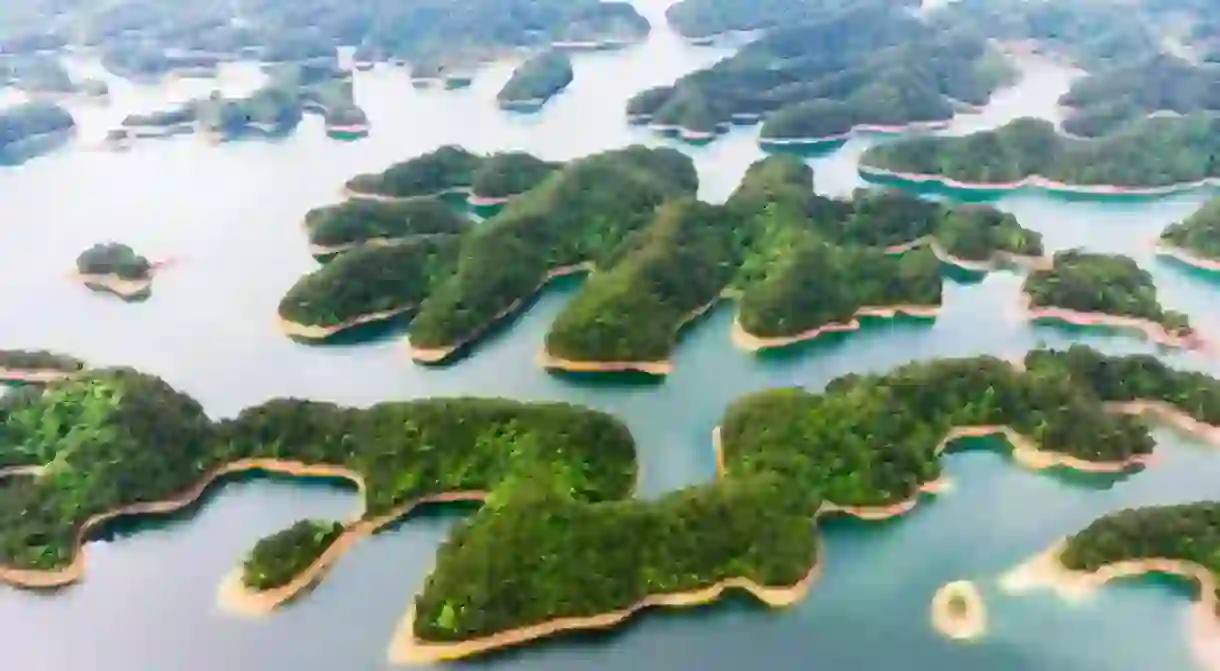The 14 Most Beautiful Places In China You Didn't Know Existed

One of the world’s largest and oldest civilizations, it’s no surprise that China is filled with countless lesser-known gems and hidden attractions waiting to be discovered. This diverse country’s astounding man-made attractions are rivaled by its remarkable natural wonders. From singing sand dunes to some of the tallest statues on the planet, here are some of the most beautiful places in China that you need to see.
Jiuzhaigou

Zhangye Danxia Landform
Natural Feature

Nicknamed the ‘painted mountains’ of Danxia, this incredible landscape is listed as a UNESCO World Heritage site. In this section of the Gobi Desert, the folding of layered oceanic crust created exposed rock layers of different colors and textures. Their unusual shapes, which resemble strange cones and towers, evolved over centuries of exposure to wind and rain and the colorful sedimentation layers add unique striped patterns.
Guanyin Statue
Architectural Landmark
This massive statue dedicated to Guanyin, the Chinese Buddhist goddess of mercy, is part of the Nanshan Temple Complex. At 354 feet, the statue towers over the surrounding area. It’s said to be the world’s tallest statue of Guanyin, as well as the fourth tallest statue on the planet. The statue has three faces, one of which looks towards the land, and the other two which point towards the South China Sea.
Dongchuan Red Land
Natural Feature, Architectural Landmark

The Dongchuan Red Land is a 77,000-square mile area located about 25 miles southwest of Kunming City. The region’s subtropical climate causes iron to oxidize and deposit in the soil, which gives it a deep red color. The red soil color is emphasized by the other colors of the surrounding landscape, contrasting against green barley, golden buckwheat, white oil flowers, and the blue sky. Often described as a ‘palette’ of colors, the area is best visited from either May to June or September to November, when various crops are ripe and the colors are most distinct.
Saint Sophia Cathedral
Cathedral, Church, Museum
Yuanyang Rice Terraces
Natural Feature

The Yuanyang Rice Terraces have been dug into the rolling landscape of the southern Ailao Mountains by the Hani people over many centuries. Covering more than 12,500 hectares, these shallow-sloped terraces reach height of up to 6500 feet above sea level. Depending on the season, the terraces are richly green or filled with water which reflects the colors and cloud shapes of the sky. Adding to the beauty of the terraces are the fascinating Hani people who farm the lands and still largely live according to the traditions of their ancestors.
Echoing Sand Mountain and Crescent Lake
Natural Feature, Architectural Landmark

The Echoing Sand Mountain is a series of sand dunes located along the Silk Road, in the Gobi desert in northwest China. The huge dunes stretch for more than 25 miles long and 12 miles wide, reaching 800 feet at their peak. Aside from their interesting shapes, the dunes are known for the haunting echoing sound they produce when strong winds blow over the sands. The dunes surround Crescent Lake, a half-mooned shaped lake that offers a pleasing contrast to the sand with the gardens blooming on its shores.
Yungang Grottoes

Yalong Bay
Hotel
Leshan Giant Buddha

Thousand Islets Lake
Ruins, Natural Feature, Architectural Landmark
Qian Dao Lake, also known as Thousand Islets Lake, is a man-made lake developed in the 1950s after the completion of the Xin’an River hydroelectric station. More than 358 square miles of villages, plains and hills were evacuated and flooded, unintentionally creating a dream-like landscape of more than 1,000 tiny islands. Many of these islands have since been developed for tourism, with some featuring themes and offering activities ranging from water skiing to mountain climbing.
Hongcun Ancient Village
Architectural Landmark

The Hongcun Ancient Village is a striking traditional village with a history that stretches back more than 1,000 years. With the crescent-shaped Moon Pond at its center, the village is a picturesque expanse of narrow lanes, old-fashioned clan halls, graceful bridges, and serene lakeside views. This charming scene is set against the dramatic backdrop of the Huangshan Mountain Range. Home to more than 140 ancient houses, the village is listed as a UNESCO World Cultural Heritage Site.
Qinghai Lake
Natural Feature

Qinghai Lake is the largest lake in China, spanning 1,616 square miles. Located in northwest China, this beautiful blue lake draws visitors in June and July when flocks of migratory birds can be seen flitting around Bird Island, which is found on the lake’s western shore. The pristine wilderness area around the lake is a popular spot for hiking, camping, and cycling. The scenery is a gorgeous mix of rolling green hills and lush farmlands dotted with sheep.
Yangshuo
Historical Landmark

Yangshuo is a scenic riverside town in southern China, and a haven for adventure travelers. The area is an excellent spot for rock climbing, hiking, caving, and biking. Although the town itself is relatively touristy, the surrounding countryside is tranquil and beautiful, with bamboo boats floating along the river, and farmers working in fertile fields bordered by towering karst peaks. Some of the most accessible karst scenery can be found a quick bike ride outside of town, in Guangxi.













